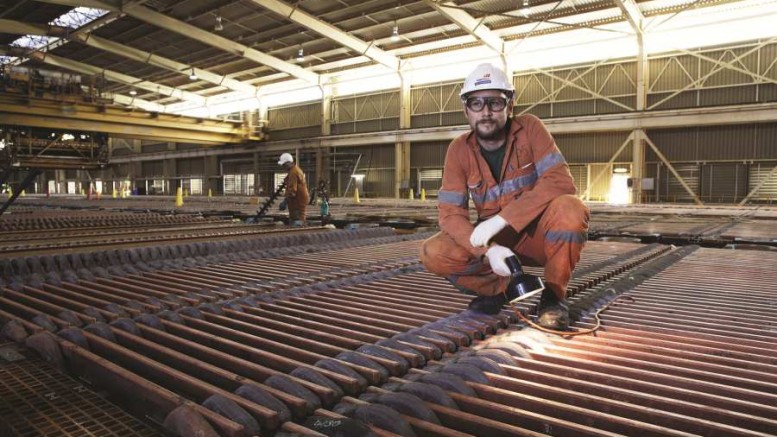BHP Billiton’s (BHP-N, BLT-L) decision to delay a US$30-billion dollar expansion of its Olympic Dam copper-uranium-gold mine in South Australia due to escalating capital costs will put a forecasted uranium supply deficit under even greater pressure, analysts say.
Edward Sterck of BMO Capital Markets in London points out that the copper-gold-uranium expansion project had been expected to boost annual production from 10 million lb. uranium oxide (U308) to more than 40 million lb. beginning in 2017, before reaching full ramp-up in 2025. The delay will make the uranium supply deficit forecast “even more acute,” he writes in a research note.
“Given that five years still remain to the anticipated start of the expansion, the immediate impact to the uranium price is not expected to be significant,” he says. “However, as higher-cost projects will be needed to fill the deficit, the uranium price is likely to increase in the intervening years.”
Sterk reasons that uranium stocks such as Cameco (CCO-T, CCJ-N), Uranium One (UUU-T) and Paladin Energy (PDN-T, PDN-A) will likely respond positively to news of the delay. And he believes that the exploration projects of non-producers like Denison Mines (DML-T, DNN-X) “might now attract more mergers and acquisitions interest,” while projects like Bannerman Resources’ (BAN-T) “low-grade but large” Etango project in Namibia, which he says was “considered uneconomic at current uranium prices, may now be edged towards production.”
Etango is one of the few uranium projects in the world with a completed definitive feasibility study (DFS). According to the DFS, Etango would produce between 7 million and 9 million lb. U308 per year for the first five years, and 6 million to 8 million lb. thereafter over a minimum mine life of 16 years. (Drilling is underway to convert inferred resources into the measured and indicated category to extend the estimated mine life to more than 20 years, the company states.) The project would be a conventional open-pit mine and sulphuric acid heap-leach operation.
Sterck’s colleague at BMO Capital Markets, analyst Tony Robson, estimates a potential multi-year delay at Olympic Dam could remove 20% of the projected world supply of uranium from the market, which could improve supply-demand fundamentals for the uranium sector.
BHP Billiton announced the delay at Olympic Dam after unveiling its full-year financial results for fiscal 2012. The miner also said that no major projects would be approved in fiscal 2013. “Such commentary was anticipated by the market, which is currently favouring capital discipline over large-scale growth,” Dahlman Rose analysts Anthony Rizzuto, Anthony Young and Joseph Giordano write in a research note to clients.
The company said it would delay an annual 2.5-million-tonne expansion at the Peak Downs metallurgical coal project, which is associated with the Caval Ridge mine development in Australia. (The Caval Ridge mine remains on schedule, however, for first production in 2014.) BHP will also delay a decision on its Outer Harbour iron-ore project, but is continuing with the Inner Harbour and mine-infrastructure projects that are already under development. On Olympic Dam, the company said large changes in the scope of the expansion project will potentially result in a multi-year delay, but confirmed that the company remains positive on the long-term outlook for copper. According to Robson of BMO Capital Markets, the company has begun studies on less capital-intensive designs involving new metallurgical technologies.
As for the 8-million-tonne-per-year Jansen potash project, Robson of BMO Capital Markets says it is “still on the table, but not yet ratified by the board.”
BHP reported that underlying profit for fiscal 2012 fell by 21% year-on-year to US$17.1 billion, or US$3.20 per share, due to weakness in commodity markets and industry-wide cost pressures. Gross revenues of US$72.2 billion were down 9% year-on-year. Net operating cash flows after interest and tax decreased by 19% to US$24.4 billion for the 2012 financial year.
The mining group noted that it has responded quickly to changes in the operating environment by taking a number of other measures, including shutting down its energy-intensive silico-manganese alloy production capacity in South Africa, and by temporarily closing capacity at Temco in Australia. It also suspended metallurgical coal production at Norwich Park, also in Australia, after reviewing the mine’s profitability. BHP also noted that the viability of other high-cost operations is being assessed, and that additional measures are being implemented that will cut operating costs. On other fronts it said the sale of its 37% stake in Richards Bay Minerals in South Africa to Rio Tinto (RIO-N) was “well advanced,” a review of its diamond business was ongoing and that it was contemplating other divestments.
Looking ahead, BHP says 20 major projects are being executed with a combined budget of US$22.8 billion.
On the Olmypic Dam news, BHP’s shares closed 21¢ or 0.30% higher at US$69.70 in New York, within a 52-week trading range of US$59.87 to $86.24.


Be the first to comment on "BHP delays Olympic Dam expansion"